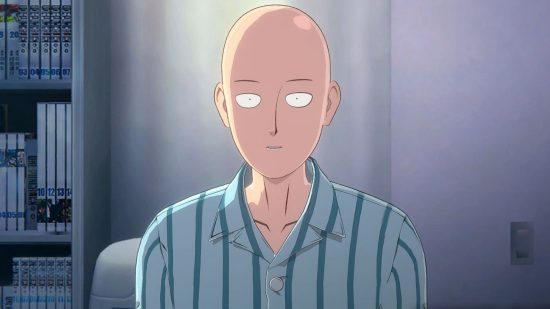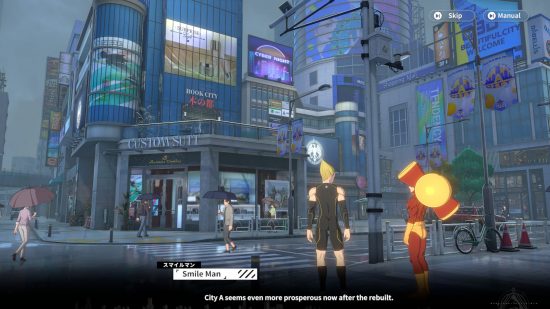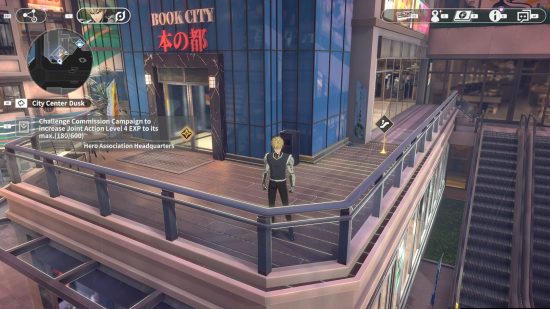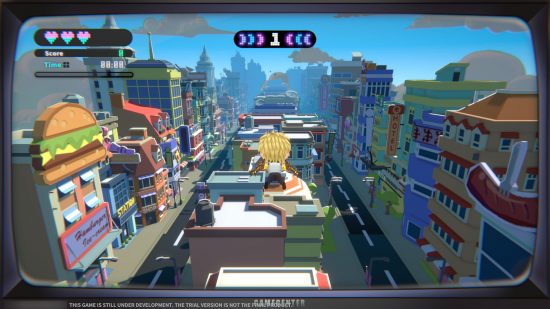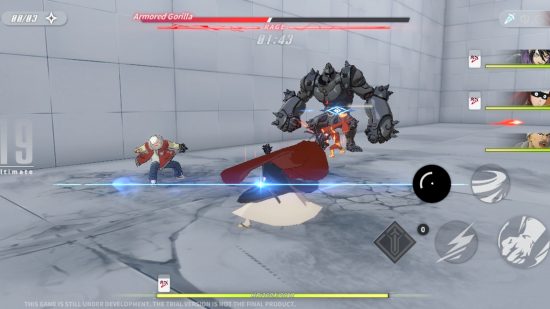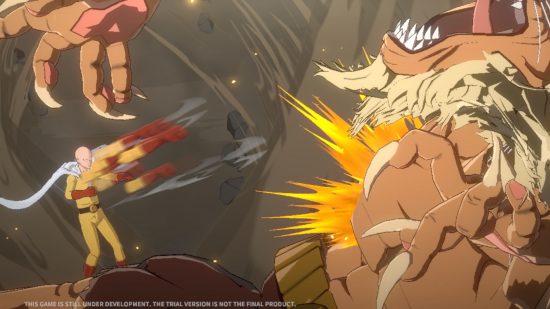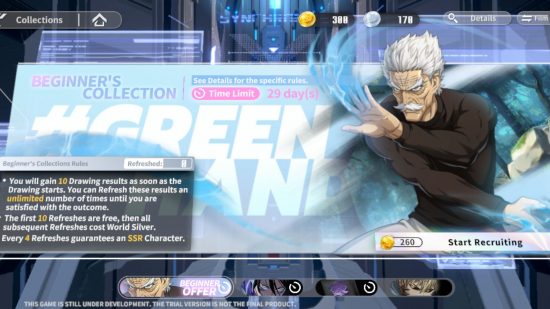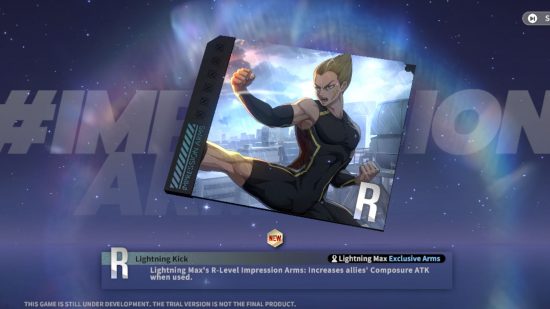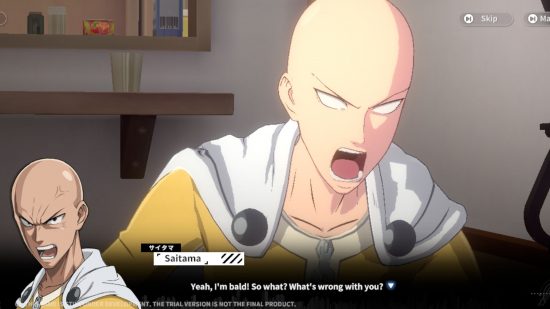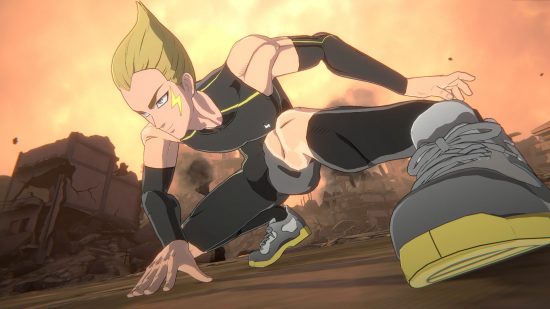One Punch Man: World is Crunchyroll’s most ambitious project to date, and is also the first of Crunchyroll’s games to officially break through the mobile barrier, smashing fist-first onto Android, iOS, and PC in late 2023. So, as a loyal fan of Saitama and the rest of the Hero Association, I couldn’t resist donning my bald cap and cape and eagerly signing up for the CBT so I could bring you this One Punch Man: World preview. But does the game truly deserve its hero license?
One Punch Man: World is, unsurprisingly, set in the world of One Punch Man. It carves out its own story of sorts, while still paralleling many iconic moments from the anime. You primarily take control of Lightning Max in the main questline, following on shortly after a devastating attack on City A.
There’s some serious tension among the civilians, as the Hero Association failed to save them and their homes from the formidable Vaccine Man, and Max, along with the other heroes, spend much of their time endeavoring to fix the damage to their reputation and rebuild trust with the people they let down, either through battling more monsters and completing commissions, or simply patrolling the towns and helping whoever they can, regardless of how small the task.
I really love the game’s exploration of that tension between civilians and heroes. It’s not anything new, by any means – in fact, Marvel has been throwing this idea about for years – but, with the ability to get down on ground level with the inhabitants of the city and actually seeing their insecurities and losses firsthand is surprisingly moving, even with the welcome One Punch Man humor woven in there for good measure.
And, while having much of the story revolve around Max felt a little odd to me initially, his upbeat, optimistic attitude, fun, bantering relationship with Smile Man and the other heroes, and hidden insecurities make him a very enjoyable and relatable protagonist, and I quickly climatized to him being at the center of the narrative.
Plus, I was pretty curious as to how Saitama could be a central protagonist in a game like this. Considering his whole character is based on him being so strong that he’s able to fell any foe with a single punch, it’d make for a pretty boring game if every battle was ‘one hit and they’re out’. I’m very pleased to see that Crunchyroll thought about this.
There are one or two sections where you get to play as the Caped Baldy in his true form, in which your goal is primarily to block and dodge until you’ve gathered enough energy to punch that baddie into oblivion. Beyond that, you can still play as Saitama – but you’re limited to his Job Hunting version, complete with a full head of hair, a suit, and a briefcase, or the Dreamworld version from the segments of the anime where he fantasizes about facing opponents that can actually put up a fight against him.
This attention to detail and faithfulness to the anime is present throughout the entire game, and I absolutely love it. It’s so clear that the devs are very familiar with the source material, and they treat it with a sense of reverence throughout, and do a great job of capturing the fun, silly, yet meaningful vibes and wrapping them up in an exciting, lore-compliant world for you to explore.
From directly quoting the anime and allowing you to get involved in some of the most iconic battles, to original content that could just as easily be pulled from the anime itself, I personally see this as the closest a game has ever gotten to capturing that classic One Punch Man charm.
The structure of the gameplay is essentially split into two. There are the combat segments, which generally take place in small arenas – I’ll get into that later – and the world exploration part, where you can traverse different sections of the city and surrounding areas (you can also choose any character you’ve unlocked as an avatar here, you’re not tied to Max all the time). The exploration gives you quite a lot of free reign, and combines elements that remind me of the upcoming Zenless Zone Zero mixed with Persona 5.
The Hero Association headquarters, city districts, and other surrounding areas are each split into smaller, separately instanced maps, most of which boast their own sub-sections. You can traverse between each main area using a teleporter that looks like a phone booth, then you can explore the different segments of each map by walking towards a threshold and hitting a button to get to the next zone.
Each area has its own unique attractions and NPCs going about their daily business – you can even bump into other heroes training, patrolling, or relaxing while out and about. There’s a day/night cycle that passes between daytime, dusk, and nighttime, and all of the NPCs and heroes have their own schedules that they stick to, so you can generally only talk to them at certain times of the day. There’s also a dynamic weather system that changes regularly, adding to the overall life and realism of the world.
The cities also have unique shops for you to explore. There are vending machines, convenience stores, and restaurants that sell consumables that give you buffs in battle, as well as other shops such as the thrift store and the manga store that serve mostly as quest-related locations. As you’re exploring, you also come across the occasional side quest or character-specific story quest from NPCs around town. These are generally pretty simple but charming, be it working out which manga a girl is talking about or preventing a man in a queue from being scammed, once again adding a nice sense of life to the game.
Finally, there are the arcades, which I absolutely adore. In City A, there’s an arcade where you can play a minigame called Panzer Cyborg. It’s kind of like Subway Surfers, in which you control a chibi version of Genos, flying over a city. You need to collect coins and other items while avoiding obstacles in order to get to the finish line and unlock the next stage. But that’s not all, as there’s also another game tied to the arcade.
There’s a guy that you can find in both the City A and City Z arcades called Detective Tissan, who tasks you with locating hidden objects around the map, from arcade coins to ‘servers’. These treasure hunts for collectibles are a pretty fun addition to the overall gameplay, breaking up the combat-fuelled grind and encouraging you to explore all the nooks and crannies of the cities. Plus, you can get some pretty great goodies as a reward for your hard work.
Now, onto the combat. Whether you’re engaging in battles to progress the story or completing commissions in exchange for materials and other rewards, combat scenarios generally follow the same format. You choose a battle against a specific enemy (or group of enemies), build a team of one to four heroes, choose whether you want to use meals or drinks pre-battle to gather some relevant boosts, then off you go to engage in combat.
Heroes align with one of four different combat types, and enemies have weaknesses to one of those types, too – so, naturally, it’s worth building your team around what your enemy is weak to. When in battle, you take control of the hero in the first character slot, while AI controls the rest of your team (I presume you may be able to fill slots with multiplayer friends in the future, but I wasn’t able to explore that during the CBT). You can’t switch which character you’re in control of after you start a battle, which is a little disappointing after getting so used to the quick swap systems in Honkai Star Rail and Genshin Impact, but battles are generally pretty short, and this system encourages you to familiarize yourself with at least one character of each battle type.
Each hero has their own unique combat skills and playstyles with some really nice variation, meaning there’s a hero to suit anyone. You have your basic controls covering movement, camera, and a dodge or dash, but each hero also has their own skills and combos. As with Genshin and HSR, the skills are represented by big icons to the bottom right. On mobile, you tap these, whereas on PC you either click them or tap an associated key.
You can win most battles by aggressively hitting skills whenever they’re off cooldown, but you might struggle to get full marks on every battle with this method. You see, there’s a surprising amount of depth in the possible combos you can pull off, be it by combining normal attacks and dashes then following up with a skill, hitting your skills in a certain order, learning when to tap or hold certain skills, or even using specific moves to dodge or deflect enemy attacks. There are also some additional elements to keep an eye on, such as gauges for different combat stances on some characters, energy for your character’s ultimates, all of your team’s equipment buffs, and ‘link’ attacks.
Sure, it’s not the most detailed combat system in the world, but it certainly pays off if you put a bit more effort into it, and with the wide range of heroes, it can take some practice to memorize the most optimal attack patterns for each character. To help you with this, there’s a series of ‘training’ arenas for each hero, teaching you all the different combos and movesets you can pull off for each character. You receive rewards for completing this for the first time, but you can return to it at any time for a refresher.
Overall, I think my biggest issue with combat is that the targeting and camera system can be a little finicky on mobile (the PC version is fine in this aspect), though there are some settings you can change in order to fiddle with camera panning and such, so there’s flexibility if this does frustrate you too.
While the main story consists of a mixture of battles, talking to certain NPCs, and completing little quests around the map, there are sections where you can’t progress in the main story until you’ve reached a certain level in your commissions. Commissions are pretty enjoyable – they’re short and sweet combat challenges that reward you with a certain set of materials upon completion. These materials can be currency, EXP materials, memory chips (a type of gear), and other handy goodies depending on what type of commission you choose.
The downside of commissions, however, is that they require intel – in fact, most rounds of combat require a certain amount of intel, even the main story combat scenarios. The concept of intel will be very familiar to you if you’ve played other live service games. It’s essentially stamina – or for a more specific parallel, it’s like Trailblaze Power in Honkai Star Rail. Intel regenerates over time but caps at 240, and most commissions take 24 intel, with some versions that offer exclusive rewards requiring 60 intel. That means, on average, you can do a maximum of ten battles in one sitting, and with each battle taking around 1-2 minutes (though some are longer), that’s not much time at all.
This artificially slows your progress to a grinding halt, and so far, there have been very few side quests to fill the time while I wait for my intel to regenerate. Don’t get me wrong, what side quests are there are great, but there’s certainly not enough content to keep you busy, so sometimes it’s a case of intel-based activities or nothing.
Naturally, you can purchase (or sometimes earn) items to replenish your intel instantly, and during the beta I had access to plenty of this resource. However, I’m concerned that this will become more of a roadblock as the game progresses, leaving you with the option of either waiting for a long time or spending currency (perhaps even real money) to speed up the process. It’s a tactic I’ve seen in other free-to-play games with microtransactions, and it’s certainly not something that I welcome – and I’m sure many other players will feel the same.
Speaking about the free-to-play microtransaction model, One Punch Man: World is very much a gacha game, with your acquisition of both heroes and impression arms (a type of gear) based on a gacha system. Of course, you get Max Lightning for free at the beginning of the game, and soon after you gain a free copy of Smile Man and Golden Ball, too. But all other heroes and their impression arms are only obtainable through the gacha system.
Heroes come in SR or SSR quality, with some iconic characters such as Saitama and Genos also coming in multiple versions. During the beta, there were three main banners. The first is the standard ‘Hall of Everything’ banner which features a variety of heroes and impression arms, with the top SSR characters including Saitama – Dreamworld, Genos – Arms Mode, and others. This banner requires one basic license per pull, and you get quite a few of these as quest rewards, though you can also purchase them from the in-game shop for 260 world gold (a currency you can earn in-game and, I presume, purchase).
The second and third banners are for the featured SSR hero and weapon, which, in this case, was a version of the SSR villain Speed-o’-Sound Sonic. These are limited-time banners that require a specific type of license. You can purchase these for the same price as the standard licenses, but you don’t get them as rewards for anything else, so they’re a bit more limited in supply.
In addition to this, there’s also a beginner’s banner – a concept that may be familiar to you if you’ve played many of the best gacha games. However, unlike the beginner Genshin Impact banner or Honkai Star Rail banner, you only get ten pulls from it – but that’s not all bad, as there’s another handy mechanic at play.
When you use the beginner banner, you get ten free rerolls of your ten pull. You can save your top three ten pulls, then keep rerolling to see if you get a better one. After the ten free rerolls are up, you can also continue to reroll at the cost of a few world gold. When you’re happy with one of your ten pull results, you can lock it in and obtain those characters. This offers a nice level of flexibility and makes it easier for you to start the game with a selection of characters that you want. In the beta, I was lucky enough to get two SSRs and two SR heroes in one of these ten pull sets. I also ended up managing to get quite a few SR and even a couple of SSR characters with the free pulls and currency I got from completing missions.
The rates across all banners state that you’re guaranteed to get at least one SR every ten pulls, and at least one SSR every 90 pulls. I’m not sure if there’s any form of 50/50 pity at play for the limited banners, and I also can’t speak on the real monetization nor the price of currencies, as the premium shop wasn’t available in the beta.
I did get quite lucky with my pulls in terms of both characters and impression arms, but the rates were likely boosted due to the beta only being a week long, and Crunchyroll provided all beta players with quite a few free pulls and other rewards to help us progress faster, so it’s hard to say just how impactful the microtransactions and banners will be on your overall enjoyment of the full game. There also appears to be some sort of battle pass, but it seemed pretty stripped back in the beta – so I presume there will be a paid version with some enticing rewards come the full release.
However, I will say that even the free SR characters are enjoyable to play and pretty strong, especially if you pour some resources into them. In fact, despite having five SSR heroes, I often found myself adding SRs like Lightning Max and Smile Man to my team, especially after I’d managed to upgrade their impression arms.
Speaking of gear and upgrading, there are a few different ways that you can make your characters stronger. First is leveling them up using EXP cards then dishing out some world notes to allow them to ‘break through’ (kind of like ascension in HSR and Genshin). You can also promote your heroes using specific monster materials, or by pulling more than one copy of a hero (similar to Genshin’s constellations or HSR’s eidolons). On top of this, you can equip your heroes with several chips that you earn from commissions and other battles, which boost specific stats.
Finally, there’s that gear you can get from the banners, called impression arms. Each character has their own set of impression arms, and when you pull one on the banner, you can activate it in the hero upgrade screen. You can then enhance these further if you pull more than one copy of that piece. Of course, this does mean that a certain amount of your power is based on gacha RNG, but a lot of the impression arms are lower than SR so you get quite a few from normal pulls.
You can choose which impression arms piece you want to ‘equip’, which allows you to activate the associated buff in battle, whether it’s equipped to your main hero or one of your allies. These buffs come in a few different forms, including attack or defense boosts for your team, and the ability to heal the two heroes with the lowest HP. The latter is super handy in some of the tougher battles, as there doesn’t appear to be any other way to heal in combat at the moment.
Of course, beyond what I’ve mentioned here, there are plenty of other gameplay features and mechanics that help flesh the game out even further, and it genuinely feels like a well-rounded, live service gacha game. I found myself looking forward to playing it on lunch breaks or after work, and I was very sad when the closed beta ended a few hours earlier than I expected in my region. And, if a game keeps pulling you back in and is capable of drumming up that type of excitement, that obviously means it’s doing something right.
One Punch Man: World’s visuals and sound design also do a great job of capturing the essence of the anime. As of the beta, all voice acting is in Japanese – I’m unsure if there will be other language dubs in the future, but I honestly prefer it this way. I’ve not been able to check whether the voice actors are the same as those in the anime, and it’s been a while since I’ve watched it, but overall the voice acting sounds very fitting for each of the characters, and I really enjoyed the sense of energy and emotion portrayed. The music is a mixture of jazziness and triumphant superhero-esque music, much like that in the show, and all other sound effects blend seamlessly into the background while still adding life to each of the environments and settings.
The visuals are impeccable in my opinion. All of the characters look exactly as they do in the anime, with their iconic facial expressions, costumes, and color palettes. The locations you explore and enemies you fight are also vibrant and familiar, and it really feels like you’ve jumped straight into the anime – and that’s exactly what I hoped for.
I played the beta on both my gaming PC and my aging Android phone (a Huawei P20, far from the best gaming phone on the market right now) and had a predominantly seamless experience across the board. The load times between locations and battles were short and snappy, and I experienced no stuttering, bugs, or framerate drops throughout my many hours in the game. I did notice the occasional glitch in cutscenes, such as an NPC canceling an animation halfway through, or a text box flashing white for a moment, but it was all pretty standard beta stuff, and hardly noticeable – it certainly didn’t impact my enjoyment of the game. And, even if you do end up finding a bug, there’s a handy unstuck-style feature in the pause menu, though I never ended up needing to use it.
Inputs on both PC and mobile are snappy and responsive, which is integral in the beat-em-up-esque battles that make up so much of the game, and the UI is nice and consistent across the board. On mobile, the buttons are clear and easy to navigate, and everything is scaled well so as to make it manageable on a small screen without getting in the way. Even if mobile gaming isn’t your usual poison of choice, the controls are intuitive and comfortable, and you don’t need a controller to get a grip on the situation, making those short commissions nice and accessible while you’re out and about (as long as you have a stable internet connection, of course).
Overall, I’m impressed with One Punch Man: World so far, and look forward to seeing where it goes in the future. It feels very reminiscent of Hoyoverse games, and is, in a lot of ways, similar to what I hope the Zenless Zone Zero release date will bring. It captures the essence of the One Punch Man anime very well, not only through the recognizable characters and locations, but also through the humor, stories, and general vibe of the world, and I applaud it for that.
While I, as always, have my reservations about the potential monetization in this game (I honestly would have preferred this be a premium title, personally), I’m excited to see what will come of Crunchyroll’s most ambitious project to date, and I’ll certainly be waving my call to arms and hopping back into battle the moment the One Punch Man: World release date drops.
Right, if you’ll excuse me, I’m off to pretend I’m doing 100 situps, 100 pushups, and 100 squats so I can befriend Saitama. If you didn’t get in on the One Punch Man: World beta and fancy some action to tide you over, check out our list of the best anime games, the best Switch fighting games, or the best mobile RPGs. Or, if you’re looking for something to play these epic games on, we’ve got you covered with our expert lists of the best portable gaming consoles and the best gaming iPhone.
